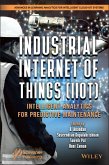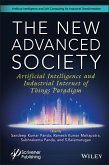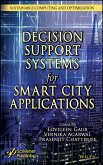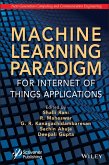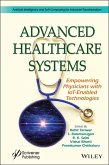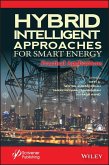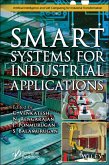Smart Systems for Industrial Applications (eBook, ePUB)
Redaktion: Venkatesh, C.; Balamurugan, S.; Ponmurugan, P.; Rengarajan, N.


Alle Infos zum eBook verschenken

Smart Systems for Industrial Applications (eBook, ePUB)
Redaktion: Venkatesh, C.; Balamurugan, S.; Ponmurugan, P.; Rengarajan, N.
- Format: ePub
- Merkliste
- Auf die Merkliste
- Bewerten Bewerten
- Teilen
- Produkt teilen
- Produkterinnerung
- Produkterinnerung

Hier können Sie sich einloggen

Bitte loggen Sie sich zunächst in Ihr Kundenkonto ein oder registrieren Sie sich bei bücher.de, um das eBook-Abo tolino select nutzen zu können.
SMART SYSTEMS FOR INDUSTRIAL APPLICATIONS The prime objective of this book is to provide an insight into the role and advancements of artificial intelligence in electrical systems and future challenges. The book covers a broad range of topics about AI from a multidisciplinary point of view, starting with its history and continuing on to theories about artificial vs. human intelligence, concepts, and regulations concerning AI, human-machine distribution of power and control, delegation of decisions, the social and economic impact of AI, etc. The prominent role that AI plays in society by…mehr
- Geräte: eReader
- mit Kopierschutz
- eBook Hilfe
- Größe: 18.82MB
![Industrial Internet of Things (IIoT) (eBook, ePUB) Industrial Internet of Things (IIoT) (eBook, ePUB)]() Industrial Internet of Things (IIoT) (eBook, ePUB)213,99 €
Industrial Internet of Things (IIoT) (eBook, ePUB)213,99 €![The New Advanced Society (eBook, ePUB) The New Advanced Society (eBook, ePUB)]() The New Advanced Society (eBook, ePUB)190,99 €
The New Advanced Society (eBook, ePUB)190,99 €![Intelligent Decision Support Systems for Smart City Applications (eBook, ePUB) Intelligent Decision Support Systems for Smart City Applications (eBook, ePUB)]() Intelligent Decision Support Systems for Smart City Applications (eBook, ePUB)96,99 €
Intelligent Decision Support Systems for Smart City Applications (eBook, ePUB)96,99 €![Machine Learning Paradigm for Internet of Things Applications (eBook, ePUB) Machine Learning Paradigm for Internet of Things Applications (eBook, ePUB)]() Machine Learning Paradigm for Internet of Things Applications (eBook, ePUB)164,99 €
Machine Learning Paradigm for Internet of Things Applications (eBook, ePUB)164,99 €![Advanced Healthcare Systems (eBook, ePUB) Advanced Healthcare Systems (eBook, ePUB)]() Advanced Healthcare Systems (eBook, ePUB)213,99 €
Advanced Healthcare Systems (eBook, ePUB)213,99 €![Hybrid Intelligent Approaches for Smart Energy (eBook, ePUB) Hybrid Intelligent Approaches for Smart Energy (eBook, ePUB)]() Hybrid Intelligent Approaches for Smart Energy (eBook, ePUB)150,99 €
Hybrid Intelligent Approaches for Smart Energy (eBook, ePUB)150,99 €![Smart Systems for Industrial Applications (eBook, PDF) Smart Systems for Industrial Applications (eBook, PDF)]() Smart Systems for Industrial Applications (eBook, PDF)190,99 €
Smart Systems for Industrial Applications (eBook, PDF)190,99 €-
-
-
Dieser Download kann aus rechtlichen Gründen nur mit Rechnungsadresse in A, B, BG, CY, CZ, D, DK, EW, E, FIN, F, GR, HR, H, IRL, I, LT, L, LR, M, NL, PL, P, R, S, SLO, SK ausgeliefert werden.
- Produktdetails
- Verlag: Jossey-Bass
- Seitenzahl: 400
- Erscheinungstermin: 7. Januar 2022
- Englisch
- ISBN-13: 9781119762041
- Artikelnr.: 63323217
- Verlag: Jossey-Bass
- Seitenzahl: 400
- Erscheinungstermin: 7. Januar 2022
- Englisch
- ISBN-13: 9781119762041
- Artikelnr.: 63323217
- Herstellerkennzeichnung Die Herstellerinformationen sind derzeit nicht verfügbar.
1 AI-Driven Information and Communication Technologies, Services, and
Applications for Next-Generation Healthcare System 1
Vijayakumar Ponnusamy, A. Vasuki, J. Christopher Clement and P. Eswaran
1.1 Introduction: Overview of Communication Technology and Services for
Healthcare 2
1.2 AI-Driven Communication Technology in Healthcare 6
1.2.1 Technologies Empowering in Healthcare 6
1.2.2 AI in Diagnosis 7
1.2.3 Conversion Protocols 8
1.2.4 AI in Treatment Assistant 9
1.2.5 AI in the Monitoring Process 10
1.2.6 Challenges of AI in Healthcare 10
1.3 AI-Driven mHealth Communication System and Services 10
1.3.1 Embedding of Handheld Imaging Platforms With mHealth Devices 12
1.3.2 The Adaptability of POCUS in Telemedicine 12
1.4 AI-Driven Body Area Network Communication Technologies and Applications
13
1.4.1 Features 16
1.4.2 Communication Architecture of Wireless Body Area Networks 16
1.4.3 Role of AI in WBAN Architecture 17
1.4.4 Medical Applications 18
1.4.5 Nonmedical Applications 18
1.4.6 Challenges 18
1.5 AI-Driven IoT Device Communication Technologies and Healthcare
Applications 20
1.5.1 AI's and IoT's Role in Healthcare 20
1.5.2 Creating Efficient Communication Framework for Remote Healthcare
Management 21
1.5.3 Developing Autonomous Capability is Key for Remote Healthcare
Management 22
1.5.4 Enabling Data Privacy and Security in the Field of Remote Healthcare
Management 24
1.6 AI-Driven Augmented and Virtual Reality-Based Communication
Technologies and Healthcare Applications 25
1.6.1 Clinical Applications of Communication-Based AI and Augmented Reality
27
1.6.2 Surgical Applications of Communication-Based on Artificial
Intelligence and Augmented Reality 28
References 30
2 Pneumatic Position Servo System Using Multi-Variable Multi-Objective
Genetic Algorithm-Based Fractional-Order PID Controller 33
D.Magdalin Mary, V.Vanitha and G.Sophia Jasmine
2.1 Introduction 34
2.2 Pneumatic Servo System 36
2.3 Existing System Analysis 38
2.4 Proposed Controller and Its Modeling 40
2.4.1 Modeling of Fractional-Order PID Controller 40
2.4.1.1 Fractional-Order Calculus 40
2.4.1.2 Fractional-Order PID Controller 42
2.5 Genetic Algorithm 43
2.5.1 GA Optimization Methodology 43
2.5.1.1 Initialization 44
2.5.1.2 Fitness Function 44
2.5.1.3 Evaluation and Selection 44
2.5.1.4 Crossover 45
2.5.1.5 Mutation 45
2.5.2 GA Parameter Tuning 46
2.6 Simulation Results and Discussion 47
2.6.1 MATLAB Genetic Algorithm Tool Box 47
2.6.2 Simulation Results 47
2.6.2.1 Reference = 500 (Error) 48
2.6.2.2 Reference = 500 52
2.6.2.3 Reference = 1,500 52
2.6.2.4 Analysis Report 56
2.7 Hardware Results 56
2.7.1 Reference = 500 58
2.7.2 Reference = 1,500 59
2.8 Conclusion 59
References 59
3 Improved Weighted Distance Hop Hyperbolic Prediction-Based Reliable Data
Dissemination (IWDH-HP-RDD) Mechanism for Smart Vehicular Environments 63
Sengathir Janakiraman, M. Deva Priya and A. Christy Jeba Malar
3.1 Introduction 64
3.2 Related Work 67
3.2.1 Extract of the Literature 70
3.3 Proposed Improved Weighted Distance Hop Hyperbolic Prediction-Based
Reliable Data Dissemination (IWDH-HP-RDD) Mechanism for Smart Vehicular
Environments 71
3.4 Simulation Results and Analysis of the Proposed IWDH-HP-RDD Scheme 79
3.5 Conclusion 89
References 90
4 Remaining Useful Life Prediction of Small and Large Signal Analog
Circuits Using Filtering Algorithms 93
Sathiyanathan M., Anandhakumar K., Jaganathan S. and Subashkumar C. S.
4.1 Introduction 94
4.2 Literature Survey 95
4.3 System Architecture 98
4.4 Remaining Useful Life Prediction 99
4.4.1 Initialization 99
4.4.2 Proposal Distribution 100
4.4.3 Time Update 101
4.4.4 Relative Entropy in Particle Resampling 101
4.4.5 RUL Prediction 102
4.5 Results and Discussion 103
4.6 Conclusion 111
References 111
5 AI in Healthcare 115
S. Menaga and J. Paruvathavardhini
5.1 Introduction 116
5.1.1 What is Artificial Intelligence? 117
5.1.2 Machine Learning - Neural Networks and Deep Learning 117
5.1.3 Natural Language Processing 119
5.2 Need of AI in Electronic Health Record 119
5.2.1 How Does AI/ML Fit Into EHR? 120
5.2.2 Natural Language Processing (NLP) 121
5.2.3 Data Analytics and Representation 122
5.2.4 Predictive Investigation 122
5.2.5 Administrative and Security Consistency 122
5.3 The Trending Role of AI in Pharmaceutical Development 123
5.3.1 Drug Discovery and Design 124
5.3.2 Diagnosis of Biomedical and Clinical Data 125
5.3.3 Rare Diseases and Epidemic Prediction 125
5.3.4 Applications of AI in Pharma 126
5.3.5 AI in Marketing 126
5.3.6 Review of the Companies That Use AI 126
5.4 AI in Surgery 127
5.4.1 3D Printing 127
5.4.2 Stem Cells 128
5.4.3 Patient Care 128
5.4.4 Training and Future Surgical Team 129
5.5 Artificial Intelligence in Medical Imaging 131
5.5.1 In Cardio Vascular Abnormalities 131
5.5.2 In Fractures and Musculoskeletal Injuries 132
5.5.3 In Neurological Diseases and Thoracic Complications 133
5.5.4 In Detecting Cancers 134
5.6 AI in Patient Monitoring and Wearable Health Devices 134
5.6.1 Monitoring Health Through Wearable's and Personal Devices 135
5.6.2 Making Smartphone Selfies Into Powerful Diagnostic Tools 136
5.7 Revolutionizing of AI in Medicinal Decision-Making at the Bedside 137
5.8 Future of AI in Healthcare 137
5.9 Conclusion 139
References 139
6 Introduction of Artificial Intelligence 141
R. Vishalakshi and S. Mangai
6.1 Introduction 142
6.1.1 Intelligence 142
6.1.2 Types of Intelligence 143
6.1.3 A Brief History of Artificial Intelligence From 1923 till 2000 144
6.2 Introduction to the Philosophy Behind Artificial Intelligence 145
6.2.1 Programming With and Without AI 147
6.3 Basic Functions of Artificial Intelligence 147
6.3.1 Categories of Artificial Intelligence 148
6.3.1.1 Reactive Machines 148
6.3.1.2 Limited Memory 148
6.3.1.3 Theory of Mind 149
6.3.1.4 Self-Awareness 149
6.4 Existing Technology and Its Review 149
6.4.1 Tesla's Autopilot 149
6.4.2 Boxever 150
6.4.3 Fin Gesture 150
6.4.4 AI Robot 152
6.4.5 Vinci 153
6.4.6 AI Glasses 153
6.4.7 Affectiva 153
6.4.8 AlphaGo Beats 154
6.4.9 Cogito 154
6.4.10 Siri and Alexa 155
6.4.11 Pandora's 157
6.5 Objectives 157
6.5.1 Major Goals 157
6.5.2 Need for Artificial Intelligence 158
6.5.3 Distinction Between Artificial Intelligence and Business Intelligence
158
6.6 Significance of the Study 159
6.6.1 Segments of Master Frameworks 160
6.6.1.1 User Interface 162
6.6.1.2 Expert Systems 163
6.6.1.3 Inference Engine 163
6.6.1.4 Voice Recognition 164
6.6.1.5 Robots 164
6.7 Discussion 164
6.7.1 Artificial Intelligence and Design Practice 164
6.8 Applications of AI 167
6.8.1 AI Has Been Developing a Huge Number of Tools Necessary to Find a
Solution to the Most Challenging Problems in Computer Science 168
6.8.2 Future of AI 168
6.9 Conclusion 169
References 170
7 Artificial Intelligence in Healthcare: Algorithms and Decision Support
Systems 173
S. Palanivel Rajan and M.Paranthaman
7.1 Introduction 173
7.2 Machine Learning Work Flow and Applications in Healthcare 176
7.2.1 Formatting and Cleaning Data 177
7.2.2 Supervised and Unsupervised Learning 178
7.2.3 Linear Discriminant Analysis 178
7.2.4 K-Nearest Neighbor 179
7.2.5 K-Means Clustering 180
7.2.6 Random Forest 181
7.2.7 Decision Tree 181
7.2.8 Support Vector Machine 182
7.2.9 Artificial Neural Network 183
7.2.10 Natural Language Processing 184
7.2.11 Deep Learning 185
7.2.12 Ensembles 186
7.3 Commercial Decision Support Systems Based on AI 187
7.3.1 Personal Genome Diagnostics 188
7.3.2 Tempus 188
7.3.3 iCarbonX-Manage Your Digital Life 189
7.3.4 H 2 O.ai 189
7.3.5 Google DeepMind 189
7.3.6 Buoy Health 189
7.3.7 PathAI 190
7.3.8 Beth Israel Deaconess Medical Center 190
7.3.9 Bioxcel Therapeutics 190
7.3.10 Berg 191
7.3.11 Enlitic 191
7.3.12 Deep Genomics 191
7.3.13 Freenome 192
7.3.14 CloudMedX 192
7.3.15 Proscia 192
7.4 Conclusion 193
References 193
8 Smart Homes and Smart Cities 199
C. N. Marimuthu and G. Arthy
8.1 Smart Homes 199
8.1.1 Introduction 199
8.1.2 Evolution of Smart Home 200
8.1.3 Smart Home Architecture 202
8.1.3.1 Smart Electrical Devices or Smart Plugs 202
8.1.3.2 Home Intelligent Terminals or Home Area Networks 203
8.1.3.3 Master Network 203
8.1.4 Smart Home Technologies 204
8.1.5 Smart Grid Technology 206
8.1.6 Smart Home Applications 206
8.1.6.1 Smart Home in the Healthcare of Elderly People 206
8.1.6.2 Smart Home in Education 207
8.1.6.3 Smart Lighting 207
8.1.6.4 Smart Surveillance 207
8.1.7 Advantages and Disadvantages of Smart Homes 207
8.2 Smart Cities 208
8.2.1 Introduction 208
8.2.2 Smart City Framework 209
8.2.3 Architecture of Smart Cities 210
8.2.4 Components of Smart Cities 211
8.2.4.1 Smart Technology 212
8.2.4.2 Smart Infrastructure 212
8.2.4.3 Smart Mobility 214
8.2.4.4 Smart Buildings 215
8.2.4.5 Smart Energy 216
8.2.4.6 Smart Governance 217
8.2.4.7 Smart Healthcare 218
8.2.5 Characteristics of Smart Cities 219
8.2.6 Challenges in Smart Cities 221
8.2.7 Conclusion 222
References 222
9 Application of AI in Healthcare 225
V. Priya and S. Prabu
9.1 Introduction 226
9.1.1 Supervised Learning Process 226
9.1.2 Unsupervised Learning Process 227
9.1.3 Semi-Supervised Learning Process 227
9.1.4 Reinforcement Learning Process 227
9.1.5 Healthcare System Using ml 228
9.1.6 Primary Examples of ML's Implementation in the Healthcare 228
9.1.6.1 AI-Assisted Radiology and Pathology 228
9.1.6.2 Physical Robots for Surgery Assistance 229
9.1.6.3 With the Assistance of AI/ML Techniques, Drug Discovery 231
9.1.6.4 Precision Medicine and Preventive Healthcare in the Future 232
9.2 Related Works 232
9.2.1 In Healthcare, Data Driven AI Models 232
9.2.2 Support Vector Machine 233
9.2.3 Artificial Neural Networks 233
9.2.4 Logistic Regression 235
9.2.5 Random Forest 235
9.2.6 Discriminant Analysis 236
9.2.7 Naïve Bayes 236
9.2.8 Natural Language Processing 236
9.2.9 Tf-idf 236
9.2.10 Word Vectors 237
9.2.11 Deep Learning 237
9.2.12 Convolutional Neural Network 237
9.3 dl Frameworks for Identifying Disease 240
9.3.1 TensorFlow 240
9.3.2 High Level APIs 240
9.3.3 Estimators 240
9.3.4 Accelerators 241
9.3.5 Low Level APIs 241
9.4 Proposed Work 241
9.4.1 Application of AI in Finding Heart Disease 241
9.4.2 Data Pre-Processing and Classification of Heart Disease 241
9.5 Results and Discussions 244
9.6 Conclusion 246
References 246
10 Battery Life and Electric Vehicle Range Prediction 249
Ravikrishna S., Subash Kumar C. S. and Sundaram M.
10.1 Introduction 250
10.2 Different Stages of Electrification of Electric Vehicles 253
10.2.1 Starting and Stopping 253
10.2.2 Regenerative Braking 253
10.2.3 Motor Control 253
10.2.4 EV Drive 254
10.3 Estimating SoC 254
10.3.1 Cell Capacity 254
10.3.2 Calendar Life 255
10.3.3 Cycling Life 255
10.3.4 SoH Based on Capacity Fade 255
10.3.5 SoH Based on Power Fade 255
10.3.6 Open Circuit Voltage 255
10.3.7 Impedance Spectroscopy 255
10.3.8 Model-Based Approach 256
10.4 Kalman Filter 257
10.4.1 Sigma Point Kalman Filter 257
10.4.2 Six Step Process 258
10.5 Estimating SoH 260
10.6 Results and Discussion 262
10.7 Conclusion 267
References 267
11 AI-Driven Healthcare Analysis 269
N. Kasthuri and T. Meeradevi
11.1 Introduction 270
11.2 Literature Review 271
11.3 Feature Extraction 275
11.3.1 GLCM Feature Descriptors 275
11.4 Classifiers 276
11.4.1 Stochastic Gradient Descent Classifier 276
11.4.2 Naïve Bayes Classifier 276
11.4.3 K-Nearest Neighbor Classifier 277
11.4.4 Support Vector Machine Classifier 277
11.4.5 Random Forest Classifier 278
11.4.6 Working of Random Forest Algorithm 278
11.4.7 Convolutional Neural Network 278
11.4.7.1 Activation Function 281
11.4.7.2 Pooling Layer 281
11.4.7.3 Fully Connected Layer (FC) 281
11.5 Results and Conclusion 282
11.5.1 5,000 Images 282
11.5.2 10,000 Images 283
References 284
12 A Novel Technique for Continuous Monitoring of Fuel Adulteration 287
Rajalakshmy P., Varun R., Subha Hency Jose P. and Rajasekaran K.
12.1 Introduction 288
12.1.1 Literature Review 289
12.1.2 Overview 290
12.1.3 Objective 290
12.2 Existing Method 290
12.2.1 Module-1 Water 291
12.2.2 Module-2 Petrol 293
12.2.3 Petrol Density Measurement 293
12.2.4 Block Diagram 293
12.2.5 Components of the System 294
12.2.5.1 Pressure Instrument 294
12.2.5.2 Sensor 294
12.2.6 Personal Computer 295
12.2.7 Petrol Density Measurement Instrument Setup 295
12.2.7.1 Setup 1 296
12.2.7.2 Setup 2 298
12.2.7.3 Setup 3 298
12.2.7.4 Setup 4 298
12.2.7.5 Final Setup 298
12.3 Interfacing MPX2010DP with INA 114 299
12.3.1 I2C Bus Configuration for Honeywell Sensor 299
12.3.2 Pressure and Temperature Output Through I2C 300
12.4 Results and Discussion 302
12.5 Conclusion 303
References 304
13 Improved Merkle Hash and Trapdoor Function-Based Secure Mutual
Authentication (IMH-TF-SMA) Mechanism for Securing Smart Home Environment
307
M. Deva Priya, Sengathir Janakiraman and A. Christy Jeba Malar
13.1 Introduction 308
13.2 Related Work 310
13.3 Proposed Improved Merkle Hash and Trapdoor Function- Based Secure
Mutual Authentication (IMH-TF-SMA) Mechanism for Securing Smart Home
Environment 316
13.3.1 Threat Model 317
13.3.2 IMH-TF-SMA Mechanism 317
13.3.2.1 Phase of Initialization 320
13.3.2.2 Phase of Addressing 320
13.3.2.3 Phase of Registration 320
13.3.2.4 Phase of Login Authentication 321
13.3.2.5 Phase of Session Agreement 321
13.4 Results and Discussion 325
13.5 Conclusion 330
References 330
14 Smart Sensing Technology 333
S. Palanivel Rajan and T. Abirami
14.1 Introduction 333
14.1.1 Sensor 333
14.1.1.1 Real-Time Example of Sensor 334
14.1.1.2 Definition of Sensors 335
14.1.1.3 Characteristics of Sensors 335
14.1.1.4 Classification of Sensors 336
14.1.1.5 Types of Sensors 336
14.1.2 IoT (Internet of Things) 340
14.1.2.1 Trends and Characteristics 340
14.1.2.2 Definition 340
14.1.2.3 Flow Chart of IoT 341
14.1.2.4 IoT Phases 341
14.1.2.5 Phase Chart 342
14.1.2.6 IoT Protocol 342
14.1.3 Wpan 343
14.1.3.1 IEEE 802.15.1 Overview 344
14.1.3.2 Bluetooth 344
14.1.3.3 History of Bluetooth 344
14.1.3.4 How Bluetooth Works 345
14.1.3.5 Bluetooth Specifications 345
14.1.3.6 Advantages of Bluetooth Technology 346
14.1.3.7 Applications 347
14.1.4 Zigbee (IEEE 802.15.4) 348
14.1.4.1 Introduction 348
14.1.4.2 Architecture of Zigbee 349
14.1.4.3 Zigbee Devices 351
14.1.4.4 Operating Modes of Zigbee 351
14.1.4.5 Zigbee Topologies 352
14.1.4.6 Applications of Zigbee Technology 353
14.1.5 Wlan 353
14.1.5.1 Introduction 353
14.1.5.2 Advantages of WLANs 355
14.1.5.3 Drawbacks of WLAN 355
14.1.6 Gsm 356
14.1.6.1 Introduction 356
14.1.6.2 Composition of GSM Networks 356
14.1.6.3 Security 358
14.1.7 Smart Sensor 358
14.1.7.1 Development History of Smart Sensors 358
14.1.7.2 Internal Parts of Smart Transmitter 359
14.1.7.3 Applications 361
14.1.8 Conclusion 365
References 365
Index 367
1 AI-Driven Information and Communication Technologies, Services, and
Applications for Next-Generation Healthcare System 1
Vijayakumar Ponnusamy, A. Vasuki, J. Christopher Clement and P. Eswaran
1.1 Introduction: Overview of Communication Technology and Services for
Healthcare 2
1.2 AI-Driven Communication Technology in Healthcare 6
1.2.1 Technologies Empowering in Healthcare 6
1.2.2 AI in Diagnosis 7
1.2.3 Conversion Protocols 8
1.2.4 AI in Treatment Assistant 9
1.2.5 AI in the Monitoring Process 10
1.2.6 Challenges of AI in Healthcare 10
1.3 AI-Driven mHealth Communication System and Services 10
1.3.1 Embedding of Handheld Imaging Platforms With mHealth Devices 12
1.3.2 The Adaptability of POCUS in Telemedicine 12
1.4 AI-Driven Body Area Network Communication Technologies and Applications
13
1.4.1 Features 16
1.4.2 Communication Architecture of Wireless Body Area Networks 16
1.4.3 Role of AI in WBAN Architecture 17
1.4.4 Medical Applications 18
1.4.5 Nonmedical Applications 18
1.4.6 Challenges 18
1.5 AI-Driven IoT Device Communication Technologies and Healthcare
Applications 20
1.5.1 AI's and IoT's Role in Healthcare 20
1.5.2 Creating Efficient Communication Framework for Remote Healthcare
Management 21
1.5.3 Developing Autonomous Capability is Key for Remote Healthcare
Management 22
1.5.4 Enabling Data Privacy and Security in the Field of Remote Healthcare
Management 24
1.6 AI-Driven Augmented and Virtual Reality-Based Communication
Technologies and Healthcare Applications 25
1.6.1 Clinical Applications of Communication-Based AI and Augmented Reality
27
1.6.2 Surgical Applications of Communication-Based on Artificial
Intelligence and Augmented Reality 28
References 30
2 Pneumatic Position Servo System Using Multi-Variable Multi-Objective
Genetic Algorithm-Based Fractional-Order PID Controller 33
D.Magdalin Mary, V.Vanitha and G.Sophia Jasmine
2.1 Introduction 34
2.2 Pneumatic Servo System 36
2.3 Existing System Analysis 38
2.4 Proposed Controller and Its Modeling 40
2.4.1 Modeling of Fractional-Order PID Controller 40
2.4.1.1 Fractional-Order Calculus 40
2.4.1.2 Fractional-Order PID Controller 42
2.5 Genetic Algorithm 43
2.5.1 GA Optimization Methodology 43
2.5.1.1 Initialization 44
2.5.1.2 Fitness Function 44
2.5.1.3 Evaluation and Selection 44
2.5.1.4 Crossover 45
2.5.1.5 Mutation 45
2.5.2 GA Parameter Tuning 46
2.6 Simulation Results and Discussion 47
2.6.1 MATLAB Genetic Algorithm Tool Box 47
2.6.2 Simulation Results 47
2.6.2.1 Reference = 500 (Error) 48
2.6.2.2 Reference = 500 52
2.6.2.3 Reference = 1,500 52
2.6.2.4 Analysis Report 56
2.7 Hardware Results 56
2.7.1 Reference = 500 58
2.7.2 Reference = 1,500 59
2.8 Conclusion 59
References 59
3 Improved Weighted Distance Hop Hyperbolic Prediction-Based Reliable Data
Dissemination (IWDH-HP-RDD) Mechanism for Smart Vehicular Environments 63
Sengathir Janakiraman, M. Deva Priya and A. Christy Jeba Malar
3.1 Introduction 64
3.2 Related Work 67
3.2.1 Extract of the Literature 70
3.3 Proposed Improved Weighted Distance Hop Hyperbolic Prediction-Based
Reliable Data Dissemination (IWDH-HP-RDD) Mechanism for Smart Vehicular
Environments 71
3.4 Simulation Results and Analysis of the Proposed IWDH-HP-RDD Scheme 79
3.5 Conclusion 89
References 90
4 Remaining Useful Life Prediction of Small and Large Signal Analog
Circuits Using Filtering Algorithms 93
Sathiyanathan M., Anandhakumar K., Jaganathan S. and Subashkumar C. S.
4.1 Introduction 94
4.2 Literature Survey 95
4.3 System Architecture 98
4.4 Remaining Useful Life Prediction 99
4.4.1 Initialization 99
4.4.2 Proposal Distribution 100
4.4.3 Time Update 101
4.4.4 Relative Entropy in Particle Resampling 101
4.4.5 RUL Prediction 102
4.5 Results and Discussion 103
4.6 Conclusion 111
References 111
5 AI in Healthcare 115
S. Menaga and J. Paruvathavardhini
5.1 Introduction 116
5.1.1 What is Artificial Intelligence? 117
5.1.2 Machine Learning - Neural Networks and Deep Learning 117
5.1.3 Natural Language Processing 119
5.2 Need of AI in Electronic Health Record 119
5.2.1 How Does AI/ML Fit Into EHR? 120
5.2.2 Natural Language Processing (NLP) 121
5.2.3 Data Analytics and Representation 122
5.2.4 Predictive Investigation 122
5.2.5 Administrative and Security Consistency 122
5.3 The Trending Role of AI in Pharmaceutical Development 123
5.3.1 Drug Discovery and Design 124
5.3.2 Diagnosis of Biomedical and Clinical Data 125
5.3.3 Rare Diseases and Epidemic Prediction 125
5.3.4 Applications of AI in Pharma 126
5.3.5 AI in Marketing 126
5.3.6 Review of the Companies That Use AI 126
5.4 AI in Surgery 127
5.4.1 3D Printing 127
5.4.2 Stem Cells 128
5.4.3 Patient Care 128
5.4.4 Training and Future Surgical Team 129
5.5 Artificial Intelligence in Medical Imaging 131
5.5.1 In Cardio Vascular Abnormalities 131
5.5.2 In Fractures and Musculoskeletal Injuries 132
5.5.3 In Neurological Diseases and Thoracic Complications 133
5.5.4 In Detecting Cancers 134
5.6 AI in Patient Monitoring and Wearable Health Devices 134
5.6.1 Monitoring Health Through Wearable's and Personal Devices 135
5.6.2 Making Smartphone Selfies Into Powerful Diagnostic Tools 136
5.7 Revolutionizing of AI in Medicinal Decision-Making at the Bedside 137
5.8 Future of AI in Healthcare 137
5.9 Conclusion 139
References 139
6 Introduction of Artificial Intelligence 141
R. Vishalakshi and S. Mangai
6.1 Introduction 142
6.1.1 Intelligence 142
6.1.2 Types of Intelligence 143
6.1.3 A Brief History of Artificial Intelligence From 1923 till 2000 144
6.2 Introduction to the Philosophy Behind Artificial Intelligence 145
6.2.1 Programming With and Without AI 147
6.3 Basic Functions of Artificial Intelligence 147
6.3.1 Categories of Artificial Intelligence 148
6.3.1.1 Reactive Machines 148
6.3.1.2 Limited Memory 148
6.3.1.3 Theory of Mind 149
6.3.1.4 Self-Awareness 149
6.4 Existing Technology and Its Review 149
6.4.1 Tesla's Autopilot 149
6.4.2 Boxever 150
6.4.3 Fin Gesture 150
6.4.4 AI Robot 152
6.4.5 Vinci 153
6.4.6 AI Glasses 153
6.4.7 Affectiva 153
6.4.8 AlphaGo Beats 154
6.4.9 Cogito 154
6.4.10 Siri and Alexa 155
6.4.11 Pandora's 157
6.5 Objectives 157
6.5.1 Major Goals 157
6.5.2 Need for Artificial Intelligence 158
6.5.3 Distinction Between Artificial Intelligence and Business Intelligence
158
6.6 Significance of the Study 159
6.6.1 Segments of Master Frameworks 160
6.6.1.1 User Interface 162
6.6.1.2 Expert Systems 163
6.6.1.3 Inference Engine 163
6.6.1.4 Voice Recognition 164
6.6.1.5 Robots 164
6.7 Discussion 164
6.7.1 Artificial Intelligence and Design Practice 164
6.8 Applications of AI 167
6.8.1 AI Has Been Developing a Huge Number of Tools Necessary to Find a
Solution to the Most Challenging Problems in Computer Science 168
6.8.2 Future of AI 168
6.9 Conclusion 169
References 170
7 Artificial Intelligence in Healthcare: Algorithms and Decision Support
Systems 173
S. Palanivel Rajan and M.Paranthaman
7.1 Introduction 173
7.2 Machine Learning Work Flow and Applications in Healthcare 176
7.2.1 Formatting and Cleaning Data 177
7.2.2 Supervised and Unsupervised Learning 178
7.2.3 Linear Discriminant Analysis 178
7.2.4 K-Nearest Neighbor 179
7.2.5 K-Means Clustering 180
7.2.6 Random Forest 181
7.2.7 Decision Tree 181
7.2.8 Support Vector Machine 182
7.2.9 Artificial Neural Network 183
7.2.10 Natural Language Processing 184
7.2.11 Deep Learning 185
7.2.12 Ensembles 186
7.3 Commercial Decision Support Systems Based on AI 187
7.3.1 Personal Genome Diagnostics 188
7.3.2 Tempus 188
7.3.3 iCarbonX-Manage Your Digital Life 189
7.3.4 H 2 O.ai 189
7.3.5 Google DeepMind 189
7.3.6 Buoy Health 189
7.3.7 PathAI 190
7.3.8 Beth Israel Deaconess Medical Center 190
7.3.9 Bioxcel Therapeutics 190
7.3.10 Berg 191
7.3.11 Enlitic 191
7.3.12 Deep Genomics 191
7.3.13 Freenome 192
7.3.14 CloudMedX 192
7.3.15 Proscia 192
7.4 Conclusion 193
References 193
8 Smart Homes and Smart Cities 199
C. N. Marimuthu and G. Arthy
8.1 Smart Homes 199
8.1.1 Introduction 199
8.1.2 Evolution of Smart Home 200
8.1.3 Smart Home Architecture 202
8.1.3.1 Smart Electrical Devices or Smart Plugs 202
8.1.3.2 Home Intelligent Terminals or Home Area Networks 203
8.1.3.3 Master Network 203
8.1.4 Smart Home Technologies 204
8.1.5 Smart Grid Technology 206
8.1.6 Smart Home Applications 206
8.1.6.1 Smart Home in the Healthcare of Elderly People 206
8.1.6.2 Smart Home in Education 207
8.1.6.3 Smart Lighting 207
8.1.6.4 Smart Surveillance 207
8.1.7 Advantages and Disadvantages of Smart Homes 207
8.2 Smart Cities 208
8.2.1 Introduction 208
8.2.2 Smart City Framework 209
8.2.3 Architecture of Smart Cities 210
8.2.4 Components of Smart Cities 211
8.2.4.1 Smart Technology 212
8.2.4.2 Smart Infrastructure 212
8.2.4.3 Smart Mobility 214
8.2.4.4 Smart Buildings 215
8.2.4.5 Smart Energy 216
8.2.4.6 Smart Governance 217
8.2.4.7 Smart Healthcare 218
8.2.5 Characteristics of Smart Cities 219
8.2.6 Challenges in Smart Cities 221
8.2.7 Conclusion 222
References 222
9 Application of AI in Healthcare 225
V. Priya and S. Prabu
9.1 Introduction 226
9.1.1 Supervised Learning Process 226
9.1.2 Unsupervised Learning Process 227
9.1.3 Semi-Supervised Learning Process 227
9.1.4 Reinforcement Learning Process 227
9.1.5 Healthcare System Using ml 228
9.1.6 Primary Examples of ML's Implementation in the Healthcare 228
9.1.6.1 AI-Assisted Radiology and Pathology 228
9.1.6.2 Physical Robots for Surgery Assistance 229
9.1.6.3 With the Assistance of AI/ML Techniques, Drug Discovery 231
9.1.6.4 Precision Medicine and Preventive Healthcare in the Future 232
9.2 Related Works 232
9.2.1 In Healthcare, Data Driven AI Models 232
9.2.2 Support Vector Machine 233
9.2.3 Artificial Neural Networks 233
9.2.4 Logistic Regression 235
9.2.5 Random Forest 235
9.2.6 Discriminant Analysis 236
9.2.7 Naïve Bayes 236
9.2.8 Natural Language Processing 236
9.2.9 Tf-idf 236
9.2.10 Word Vectors 237
9.2.11 Deep Learning 237
9.2.12 Convolutional Neural Network 237
9.3 dl Frameworks for Identifying Disease 240
9.3.1 TensorFlow 240
9.3.2 High Level APIs 240
9.3.3 Estimators 240
9.3.4 Accelerators 241
9.3.5 Low Level APIs 241
9.4 Proposed Work 241
9.4.1 Application of AI in Finding Heart Disease 241
9.4.2 Data Pre-Processing and Classification of Heart Disease 241
9.5 Results and Discussions 244
9.6 Conclusion 246
References 246
10 Battery Life and Electric Vehicle Range Prediction 249
Ravikrishna S., Subash Kumar C. S. and Sundaram M.
10.1 Introduction 250
10.2 Different Stages of Electrification of Electric Vehicles 253
10.2.1 Starting and Stopping 253
10.2.2 Regenerative Braking 253
10.2.3 Motor Control 253
10.2.4 EV Drive 254
10.3 Estimating SoC 254
10.3.1 Cell Capacity 254
10.3.2 Calendar Life 255
10.3.3 Cycling Life 255
10.3.4 SoH Based on Capacity Fade 255
10.3.5 SoH Based on Power Fade 255
10.3.6 Open Circuit Voltage 255
10.3.7 Impedance Spectroscopy 255
10.3.8 Model-Based Approach 256
10.4 Kalman Filter 257
10.4.1 Sigma Point Kalman Filter 257
10.4.2 Six Step Process 258
10.5 Estimating SoH 260
10.6 Results and Discussion 262
10.7 Conclusion 267
References 267
11 AI-Driven Healthcare Analysis 269
N. Kasthuri and T. Meeradevi
11.1 Introduction 270
11.2 Literature Review 271
11.3 Feature Extraction 275
11.3.1 GLCM Feature Descriptors 275
11.4 Classifiers 276
11.4.1 Stochastic Gradient Descent Classifier 276
11.4.2 Naïve Bayes Classifier 276
11.4.3 K-Nearest Neighbor Classifier 277
11.4.4 Support Vector Machine Classifier 277
11.4.5 Random Forest Classifier 278
11.4.6 Working of Random Forest Algorithm 278
11.4.7 Convolutional Neural Network 278
11.4.7.1 Activation Function 281
11.4.7.2 Pooling Layer 281
11.4.7.3 Fully Connected Layer (FC) 281
11.5 Results and Conclusion 282
11.5.1 5,000 Images 282
11.5.2 10,000 Images 283
References 284
12 A Novel Technique for Continuous Monitoring of Fuel Adulteration 287
Rajalakshmy P., Varun R., Subha Hency Jose P. and Rajasekaran K.
12.1 Introduction 288
12.1.1 Literature Review 289
12.1.2 Overview 290
12.1.3 Objective 290
12.2 Existing Method 290
12.2.1 Module-1 Water 291
12.2.2 Module-2 Petrol 293
12.2.3 Petrol Density Measurement 293
12.2.4 Block Diagram 293
12.2.5 Components of the System 294
12.2.5.1 Pressure Instrument 294
12.2.5.2 Sensor 294
12.2.6 Personal Computer 295
12.2.7 Petrol Density Measurement Instrument Setup 295
12.2.7.1 Setup 1 296
12.2.7.2 Setup 2 298
12.2.7.3 Setup 3 298
12.2.7.4 Setup 4 298
12.2.7.5 Final Setup 298
12.3 Interfacing MPX2010DP with INA 114 299
12.3.1 I2C Bus Configuration for Honeywell Sensor 299
12.3.2 Pressure and Temperature Output Through I2C 300
12.4 Results and Discussion 302
12.5 Conclusion 303
References 304
13 Improved Merkle Hash and Trapdoor Function-Based Secure Mutual
Authentication (IMH-TF-SMA) Mechanism for Securing Smart Home Environment
307
M. Deva Priya, Sengathir Janakiraman and A. Christy Jeba Malar
13.1 Introduction 308
13.2 Related Work 310
13.3 Proposed Improved Merkle Hash and Trapdoor Function- Based Secure
Mutual Authentication (IMH-TF-SMA) Mechanism for Securing Smart Home
Environment 316
13.3.1 Threat Model 317
13.3.2 IMH-TF-SMA Mechanism 317
13.3.2.1 Phase of Initialization 320
13.3.2.2 Phase of Addressing 320
13.3.2.3 Phase of Registration 320
13.3.2.4 Phase of Login Authentication 321
13.3.2.5 Phase of Session Agreement 321
13.4 Results and Discussion 325
13.5 Conclusion 330
References 330
14 Smart Sensing Technology 333
S. Palanivel Rajan and T. Abirami
14.1 Introduction 333
14.1.1 Sensor 333
14.1.1.1 Real-Time Example of Sensor 334
14.1.1.2 Definition of Sensors 335
14.1.1.3 Characteristics of Sensors 335
14.1.1.4 Classification of Sensors 336
14.1.1.5 Types of Sensors 336
14.1.2 IoT (Internet of Things) 340
14.1.2.1 Trends and Characteristics 340
14.1.2.2 Definition 340
14.1.2.3 Flow Chart of IoT 341
14.1.2.4 IoT Phases 341
14.1.2.5 Phase Chart 342
14.1.2.6 IoT Protocol 342
14.1.3 Wpan 343
14.1.3.1 IEEE 802.15.1 Overview 344
14.1.3.2 Bluetooth 344
14.1.3.3 History of Bluetooth 344
14.1.3.4 How Bluetooth Works 345
14.1.3.5 Bluetooth Specifications 345
14.1.3.6 Advantages of Bluetooth Technology 346
14.1.3.7 Applications 347
14.1.4 Zigbee (IEEE 802.15.4) 348
14.1.4.1 Introduction 348
14.1.4.2 Architecture of Zigbee 349
14.1.4.3 Zigbee Devices 351
14.1.4.4 Operating Modes of Zigbee 351
14.1.4.5 Zigbee Topologies 352
14.1.4.6 Applications of Zigbee Technology 353
14.1.5 Wlan 353
14.1.5.1 Introduction 353
14.1.5.2 Advantages of WLANs 355
14.1.5.3 Drawbacks of WLAN 355
14.1.6 Gsm 356
14.1.6.1 Introduction 356
14.1.6.2 Composition of GSM Networks 356
14.1.6.3 Security 358
14.1.7 Smart Sensor 358
14.1.7.1 Development History of Smart Sensors 358
14.1.7.2 Internal Parts of Smart Transmitter 359
14.1.7.3 Applications 361
14.1.8 Conclusion 365
References 365
Index 367

